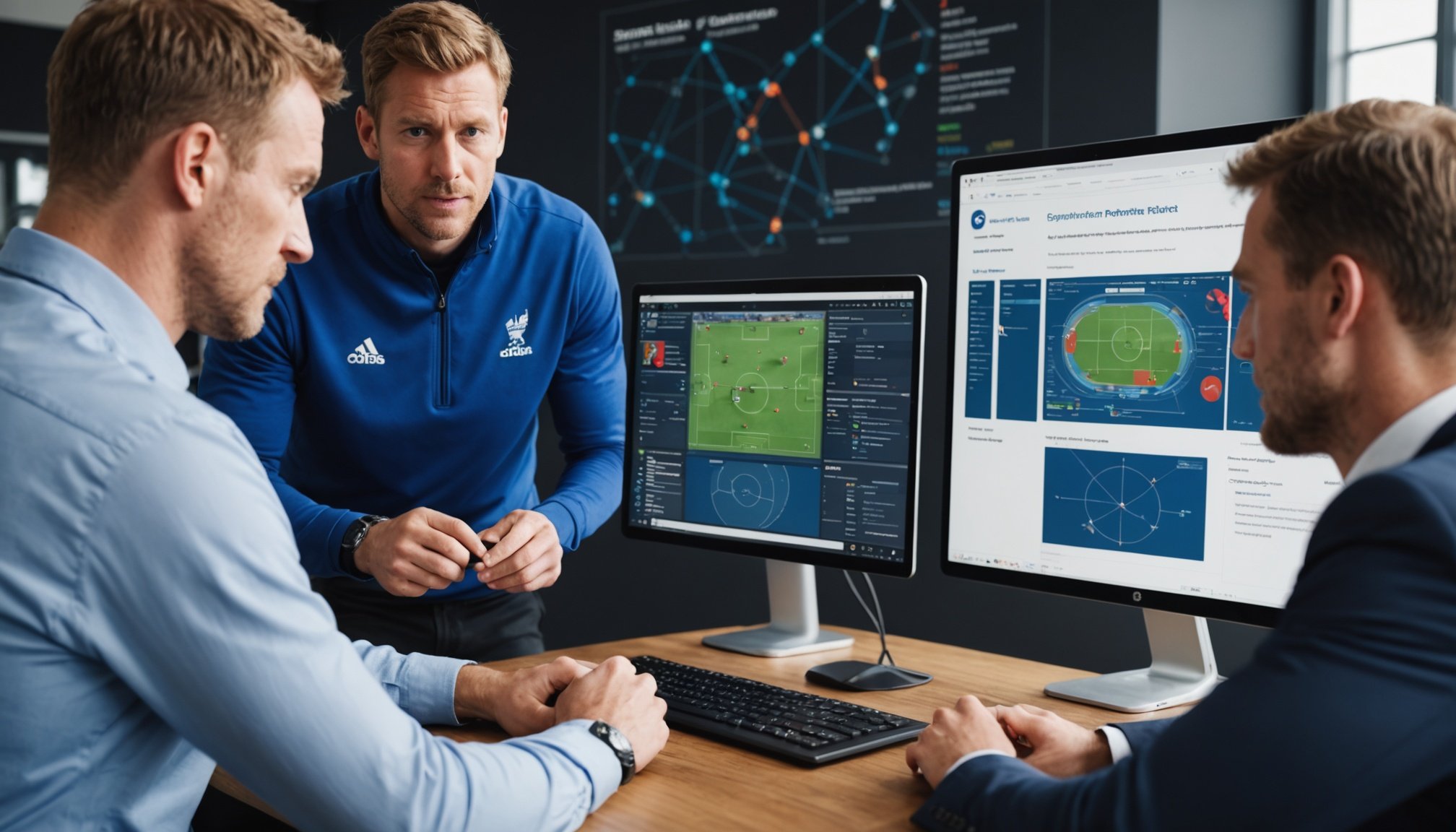Unlocking Performance Potential: The Ultimate Technology Blueprint for UK Sports Teams
In the fast-paced and highly competitive world of sports, leveraging the latest technology is crucial for teams aiming to enhance their performance and stay ahead of the competition. This article delves into the comprehensive technology blueprint that UK sports teams can adopt to unlock their full potential, from data analytics and artificial intelligence to strategic recruitment and real-time feedback.
The Power of Data Analytics in Sports
Data analytics has revolutionized the sports sector, enabling teams to make informed decisions and optimize their performance. Here’s how UK sports teams can harness this power:
In the same genre : Maximizing athlete performance: harnessing data analytics for superior results in uk sports teams
Collecting and Analyzing Data
Data collection is the foundation of any analytics-driven strategy. Teams can gather data from various sources, including player tracking systems, fitness monitors, and match footage. For instance, Brentford FC, under the guidance of Thomas Frank and the director of football Phil Giles, uses statistical and analytical approaches to recruit players and plan for the future. As Giles noted, “You can’t buy a player to solve a problem – you’ve got to think long term and be as patient as possible”[1].
Key Metrics and KPIs
Teams need to focus on the right metrics to derive meaningful insights. Here are some key performance indicators (KPIs) that can be crucial:
Also read : Engaging fans like never before: creative social media tactics for uk sports teams
- Player Performance Metrics: Passing accuracy, shot conversion rates, and distance covered during matches.
- Injury Prevention: Monitoring physical activity and health metrics to predict and prevent injuries.
- Tactical Analysis: Analyzing opponent strengths and weaknesses to develop effective game plans.
Case Study: Manchester City’s Vulnerabilities
Manchester City’s recent struggles against counter-attacks highlight the importance of data-driven tactics. According to Opta, Manchester City have allowed 47 fast breaks in all competitions this season, nearly 70% more than any other Premier League side. This data suggests that opponents are exploiting City’s midfield vulnerabilities, a insight that other teams can use to their advantage[2].
Leveraging Artificial Intelligence for High Performance
Artificial intelligence (AI) is becoming increasingly integral to sports technology, offering advanced tools for performance enhancement.
AI in Player Recruitment
AI can help in identifying potential talent by analyzing vast amounts of data on young players. For example, AI algorithms can assess a player’s skills, physical attributes, and game intelligence to predict their future performance. This approach has been successfully adopted by clubs like Brentford, who have built a strong recruitment strategy based on long-term potential rather than immediate needs[1].
Real-Time Feedback and Coaching
AI-powered systems can provide real-time feedback to players and coaches during matches and training sessions. This immediate analysis can help in making tactical adjustments and improving performance on the fly.
Health and Injury Prevention
AI-driven health monitoring systems can predict the likelihood of injuries based on player data. This proactive approach can help teams in maintaining a healthier squad and reducing downtime due to injuries.
Building a Strong Team Strategy
A well-structured team strategy is essential for success in sports. Here’s how UK teams can build a robust strategy using technology:
Recruitment Strategy
A forward-thinking recruitment strategy, like the one at Brentford, focuses on long-term growth rather than short-term fixes. Here are some key points to consider:
- Statistical Modelling: Use data analytics to identify players who fit the team’s playing style and have growth potential.
- Progressive Philosophy: Ensure that the recruitment process aligns with the club’s overall philosophy and long-term goals.
- Player Development: Invest in players who can grow and contribute over several years, rather than just immediate impact players.
Tactical Planning
Technology can aid in tactical planning by analyzing opponent data and identifying weaknesses. For instance, Ruben Amorim’s approach against Manchester City involves using a back three that becomes a back five to soak up pressure and exploit City’s vulnerabilities on the counter-attack[2].
Active Partnerships and Community Engagement
Active partnerships and community engagement are vital for the sustainability and success of sports teams.
Sport England Initiatives
Sport England, a key body in promoting sports in England, has several initiatives to encourage physical activity among young people and women. These initiatives can be leveraged by teams to build stronger community ties and support.
- Active Lives Survey: This survey provides data on physical activity levels across different demographics, helping teams to target specific groups for engagement.
- Women in Sport: Programs aimed at increasing women’s participation in sport can help teams in building a more diverse and inclusive fan base.
Health Benefits and Physical Activity
Promoting physical activity is not only beneficial for the team but also for the community. Here are some ways teams can encourage physical activity:
- Community Programs: Organize training sessions, workshops, and other activities that encourage people to engage in physical activity.
- Health Initiatives: Partner with health organizations to promote the health benefits of physical activity, especially among children and young people.
Real-Time Technology and Feedback
Real-time technology is transforming the way teams train, play, and analyze their performance.
Wearable Technology
Wearable devices can provide real-time data on player performance, including heart rate, distance covered, and other physical metrics. This data can be used to adjust training sessions and match strategies on the fly.
Video Analysis
Advanced video analysis tools allow coaches to review matches and training sessions in real-time, providing immediate feedback to players. This can significantly improve performance by identifying and correcting mistakes quickly.
Table: Comparison of Key Sports Technology Tools
| Technology Tool | Description | Benefits |
|---|---|---|
| Data Analytics Software | Collects and analyzes player and team data | Informed decision-making, performance optimization |
| Artificial Intelligence | Predicts player performance, identifies recruitment targets, and provides real-time feedback | Enhanced recruitment, improved coaching, injury prevention |
| Wearable Technology | Monitors physical activity and health metrics in real-time | Personalized training, injury prevention, real-time performance tracking |
| Video Analysis Tools | Analyzes match and training footage in real-time | Immediate feedback, tactical adjustments, performance improvement |
| Statistical Modelling | Uses statistical models to predict player and team performance | Long-term planning, recruitment strategy, performance prediction |
Practical Insights and Actionable Advice
Here are some practical tips for UK sports teams looking to leverage technology to enhance their performance:
Invest in Data Infrastructure
Building a robust data infrastructure is crucial for collecting, analyzing, and acting on data insights. This includes investing in data analytics software, wearable technology, and video analysis tools.
Foster a Data-Driven Culture
Encourage a culture within the team where data-driven decisions are valued. This involves training staff and players to understand and use data effectively.
Engage with the Community
Active partnerships with the community can help in promoting physical activity and building a stronger fan base. Partner with local organizations and participate in initiatives that encourage young people and women to engage in sports.
Focus on Long-Term Growth
Adopt a long-term approach to recruitment and player development. This involves identifying players with growth potential and investing in their development over several years.
In the modern sports landscape, technology is no longer a luxury but a necessity for teams aiming to achieve high performance. By leveraging data analytics, artificial intelligence, real-time feedback, and strategic partnerships, UK sports teams can unlock their full potential and compete at the highest level.
As Thomas Frank of Brentford FC has demonstrated, a combination of forward-thinking recruitment strategies, data-driven decision-making, and a strong team ethos can lead to remarkable success even in the face of high-profile exits. By embracing these technologies and strategies, teams can ensure they remain competitive, sustainable, and successful in the long term.
In the words of Phil Giles, “Thomas wants the best team available and wants to win every game, and I do too. That’s the main thing.” This mindset, coupled with the right technological tools, is the blueprint for success in the world of sports.











